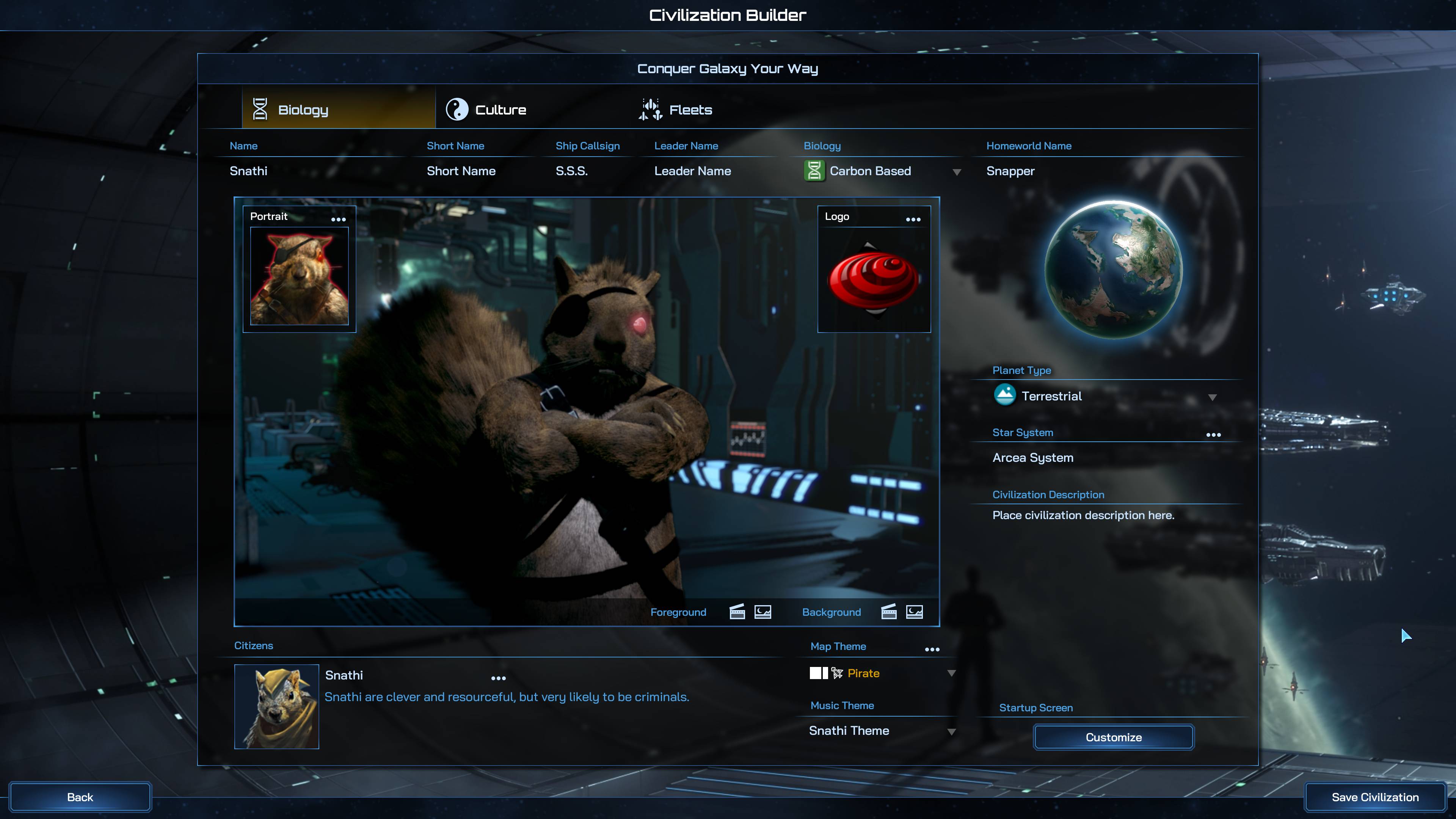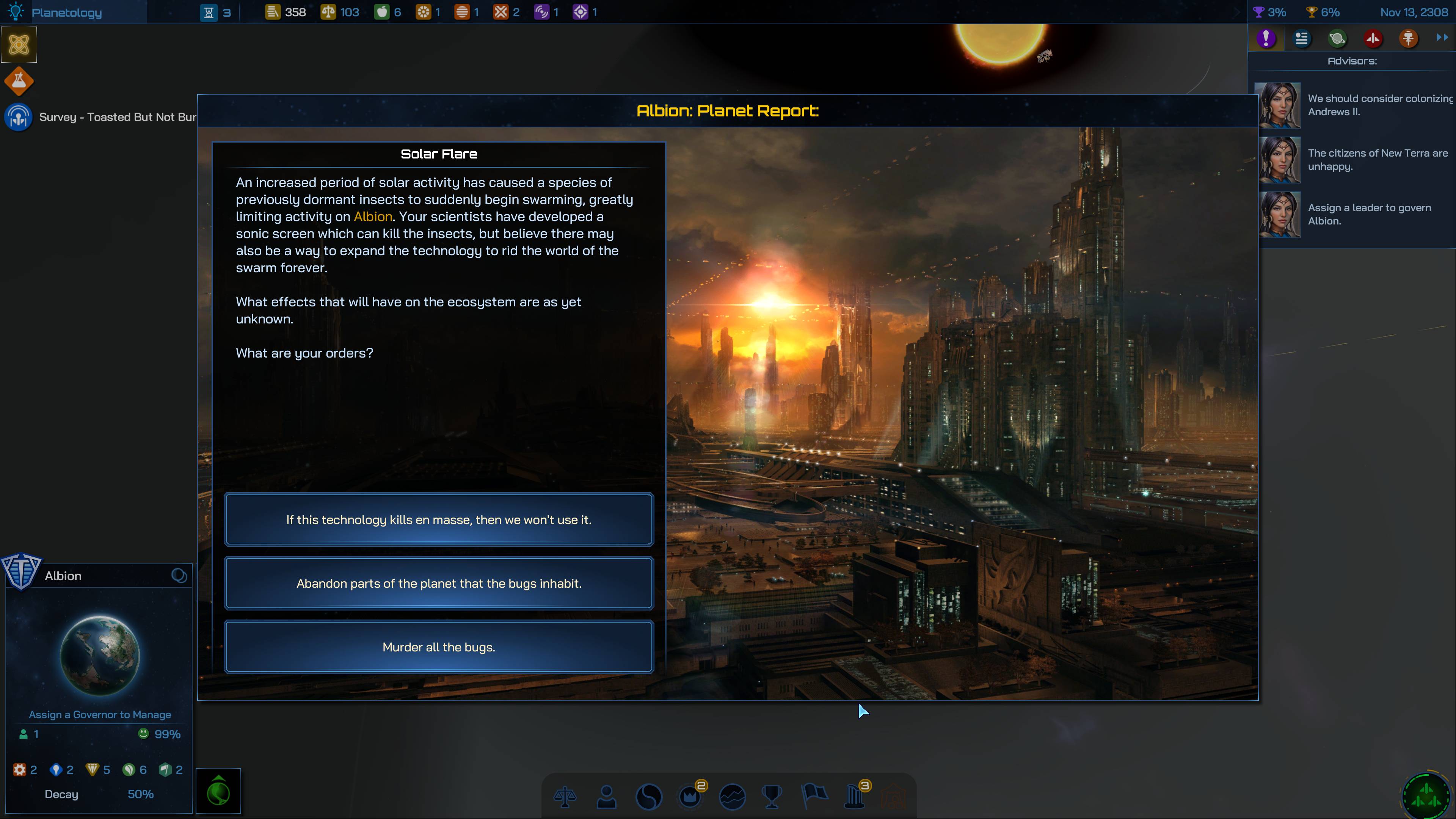Our Verdict
Galactic Civilizations 4 is a vast and dependable grand space strategy. But there's little here that radical, and expect to meet it halfway.
PC Gamer's got your back
Galactic Civilizations 4 bills itself as the most accessible game in the series. This is true, in the same way that the tail is the most accessible part of a tiger. Stardock's long running 4X series officially has a tutorial now, in the form of a little robot helper accursedly nicknamed 'Space Clippy.' But Space Clippy doesn't help much when a game explains everything as if it's arrived from another dimension.
What is it? Colourful, deep space 4X game
Expect to pay: £39.99
Developer: Stardock
Publisher: Stardock
Reviewed on: AMD Ryzen 5 3600, Nvidia GeForce 2080 Super, 32 GB RAM,
Multiplayer: Yes
Link: GalCiv4.com
Take modules as an example. What are modules, you ask? Well, so did I. At first I thought modules were optional extras you could select to tailor your starbases (which act as both resource harvesters and deployable control points, with modules helping improve those functions in various ways). But then I ran out of modules, whereupon I realised they are in fact a consumable resource. Yet unlike almost every other resource in the game, which are either harvested in space or produced on planets, modules are constructed at shipyards.
Oh, and you can only construct modules once you've researched the relevant technology, another issue I'll get into later.
As with many other systems, GalCiv never properly explains any of this. Space Clippy just points you to various menus like a dismissive waiter in an alien restaurant. The irony is GalCiv 4 is not as obtuse as it seems. It's just terrible at communicating, which means enjoying the game at its best involves a lot of false starts.
Space... is big
This isn't merely about understanding individual systems: it's also about how key features are presented. Take the game's biggest new idea, sectors. Rather than display its universe as one vast expanse of stars, GalCiv 4 splits the cosmos into self-contained bubbles, connected to one another by subspace warps (aka space roads). You can play on randomly generated maps with around a dozen of these bubbles, each of which has roughly 30 stars in it.
This lets Stardock proclaim GalCiv 4 the largest game in the series ever. Yet while visually impressive, playing at this scale isn't all that fun. 'Galactic' size games are painfully slow, while ship management becomes extremely fiddly as you're constantly having to zoom in and out to issue orders to individual fleets. GalCiv is more fun on smaller maps. Not only does the game move faster with empires forced to rub shoulders more, but the strategic importance of sectors becomes more acute, as those space roads connecting them turn into highways that can be monitored (although not completely blockaded) to help defend your empire.






Not that keeping invaders out will guarantee victory. GalCiv 4 introduces a new victory condition called "Prestige". This tracks how awesome your empire is in a wide range of categories, awarding you Prestige points to reflect how good your military or research or tourism industry is. Gain sufficient prestige points, and you win the game. This helps facilitate nonviolent victories and prevent larger-scale maps from descending into wars of attrition. You can also gain Prestige bonuses by completing a range of quests that replace the standard campaign of previous games, unlocking as your civilization meets certain criteria. This lets you experience the "story" of GalCiv 4 without being forced to play as a specific faction.
Deep thought
GalCiv 4 just doesn't have much of a hook compared to other space 4X games
Those welcome additions are accompanied by the distinction between colonies and core worlds. Core worlds are planets managed by you directly. You'll assign a governor to them, construct productivity-boosting buildings on them, and have the option to build a starbase nearby. Colonies, on the other hand, require no direct management, simply funnelling their resources to the nearest core world.
The idea is to reduce your management duties from upward of a hundred planets to perhaps a dozen or two. And it works—or at least, it does once you've figured out how to effectively differentiate between colonies and core worlds. A colony becomes a core world when you assign a governor to it, so functionally it's up to you to decide. But only worlds with "Excellent" ratings or above are worth turning into core worlds. Since the game doesn't tell you this, it's easy to rush into colonising a bunch of barely habitable backwaters while the AI nicks all the good planets from under your nose, snout, or proboscis.
The "proper" way to establish core worlds is slow and involved, and you may find yourself more inclined to direct intervention. Conquering other empires is mechanically straightforward: you just click on a fleet or planet to attack it, then wait until the battle or siege is resolved. Again though, GalCiv fails to mention that core worlds can only be conquered after researching a specific technology called Planetary Invasion. Colonies, on the other hand, can be snatched at any time with any ship, even a lone starfighter. This goes too far the other way, with wars descending into glorified pest control unless you ensure all colonies have a couple of ships stationed to defend them.
Don't panic







Once you've parsed GalCiv's garbled attempts to communicate with you the universe feels sufficiently weird and ripe with possibility for a sprawling sci-fi sandbox. Not just in the various races you encounter, which range from fleshly mantis-like creatures who thrive on oceanic worlds, to armies of sentient robots who don't need food to survive, but also in the many anomalies that you can scan for minor rewards, such as ships you can patch up from wreck sites, or strange artifacts that provide you with one-off powers.
As your empire develops you'll unlock a range of "executive orders", special edicts that can instantly recruit a new colony ship, boost your income, or reveal a new system on the map. In a game where progress is highly gradual, these quickfire bonuses offer a satisfying immediacy. In one instance I used an artifact to give a colony ship an extra move, helping it evade a fleet of pirates and beat a rival vessel to the best planet in the sector.
As the game unfolds your avenues of approach become more varied. Diplomacy, for example, initially seems limited, and it's difficult to get anything resembling a decent deal from other factions. As you gain access to better diplomacy tech your options for forming different relationships and alliances expand considerably. There are still issues though, like enemies who sue for peace during a war while refusing to offer any incentives for you to stop.
So long…
Indeed, while most of GalCiv's "problems" stem from poor onboarding, there are a few other black holes visible amid the background glow of competence. By far the biggest is research. GalCiv's tech tree is more of a tech arboretum, so to make decisions easier, the game presents you with several new techs, pruned semi-randomly from the tree, to pick from as your next research project. This works fine until you actively want to pursue a specific tech, like say, the Planetary Invasion system I mentioned earlier, which is an important mechanic to leave to the whims of chance.
You can trade tech with other races—which is how I eventually got it—but they have to be willing to trade it with you, a situation by no means guaranteed.






More broadly, GalCiv 4 just doesn't have much of a hook compared to other space 4X games. There's little here you haven’t seen done better in, say, Stellaris, such as the nuggets of narrative tied to anomalies. Other new features, such as the Crusader Kings-style relationship you have with Governors and Citizens, are highly simplistic, basically meaning that a planet might abandon you for another faction if you let the Governor's opinion of you drop too low. The ship editor is nice, going well with GalCiv's general visual snazziness. But it's very much an auxiliary feature, with little meaningful impact.
Galactic Civilizations 4 is like an ancient alien race awakening to find a bunch of pioneering little upstarts have hit the scene, all buzzing around with their hot new spaceships and innovative ideas. Its response to this is to go big, but it's also broad and conservative. Space Clippy represents a token effort to make contact, but Galactic Civilizations 4 ultimately doesn't really care if the message is understood.
It's got a legacy spanning decades, disciples in their thousands and a formula for space exploration that's worked since time immemorial. It doesn't need your approval. It's GalCiv.
Galactic Civilizations 4 is a vast and dependable grand space strategy. But there's little here that radical, and expect to meet it halfway.
Rick has been fascinated by PC gaming since he was seven years old, when he used to sneak into his dad's home office for covert sessions of Doom. He grew up on a diet of similarly unsuitable games, with favourites including Quake, Thief, Half-Life and Deus Ex. Between 2013 and 2022, Rick was games editor of Custom PC magazine and associated website bit-tech.net. But he's always kept one foot in freelance games journalism, writing for publications like Edge, Eurogamer, the Guardian and, naturally, PC Gamer. While he'll play anything that can be controlled with a keyboard and mouse, he has a particular passion for first-person shooters and immersive sims.


